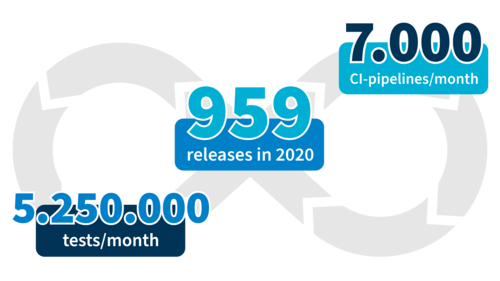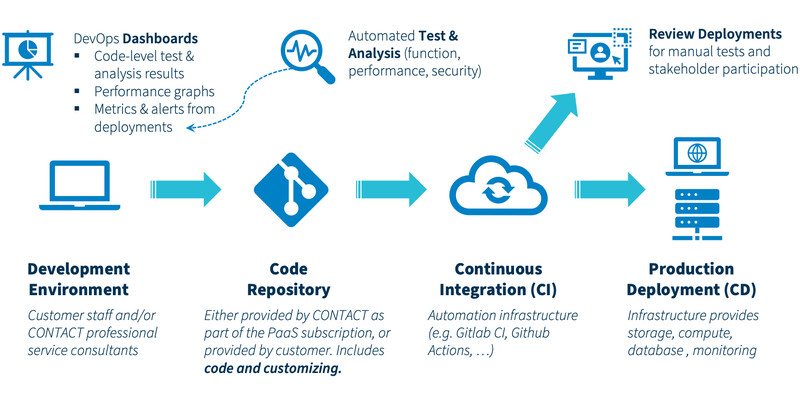Setup and benefits of a DevOps infrastructure
DevOps is the fastest and safest way to validate and roll out changes, new applications, or versions of CONTACT Elements and the products based on our platform. Customers can also save time, money, and nerves if software updates no longer must be tested manually due to IT automation.
DevOps systematizes and simplifies collaboration between development and system design (Dev) and operations (Ops) through a standardized approach for rolling out new software functions, modules, or versions. The individual work steps are largely automated and make managing and transporting changes between development, test, and production environments much easier and more reliable. This article describes how the process works and which tools we use in-house.
Continuous bookkeeping & quality assurance
A version control system for software ensures the professional operation of CONTACT Elements and other IT solutions. The SCM system (Software Configuration Management or Source Code Management) keeps a record of every change to development statuses and organizes the cooperation of all those involved. At CONTACT and in many customer projects, git is used for this purpose; in principle, any SCM system is suitable.
Based on version management, an automatic, ongoing quality assurance (Continuous Integration) is established: A CI system observes the changes in the SCM system and executes predefined steps for each change introduced. Automatic tests should be part of this in any case, and further analyses are also recommended.
The CI system also automates the provision of test environments (review deployments) for changes or development branches. This is particularly relevant in larger projects with many concurrent activities. In this way, key figures such as test coverage or quality trends can be derived from the results of the CI pipelines, whereas with a test environment that is only maintained manually, the individual changes cannot be evaluated separately.
The DevOps process offers another significant advantage: as soon as a new software version is released, it is transferred fully automatically to a production environment or an upstream QA instance at the customer (continuous deployment).
Conclusion
The benefits of such an approach are obvious: DevOps significantly accelerates the commissioning of the new software (stands) and at the same time ensures the high quality of every change, which project members and key users can also check more easily. Major changes in a company's IT environment no longer have to be prepared over months, lead times are reduced to weeks, days, or even hours, and improvements are rolled out continuously. The users will thank you!
Last but not least, automation according to the DevOps principle enforces the clear and "programmed" description of all processes up to the production system. In the event of a ransomware attack, a fire, or other crises, the automatic recovery of a central enterprise application is invaluable. This is because the effort involved in an IT infrastructure that has been built up manually over years is enormous and is usually completely underestimated. DevOps and automation are strategic capabilities of an IT organization, especially from this point of view.
CONTACT has extensive DevOps experience that we can bring to the IT projects of companies so that new or further developed software can move more quickly from their internal test environment to the productive system. At no extra cost, our cloud customers benefit from a predefined DevOps infrastructure that allows them to easily take advantage of this approach.



